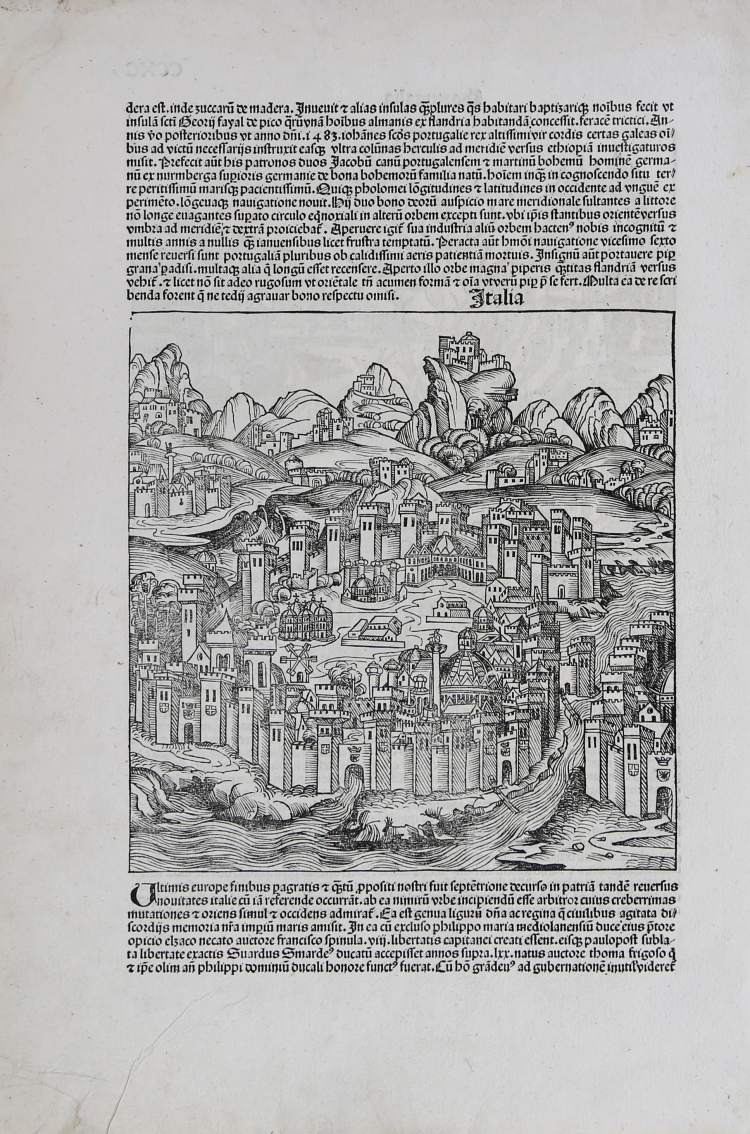



| Reference: | CO-155 |
| Author | Hartmann SCHEDEL |
| Year: | 1493 |
| Zone: | Italy |
| Printed: | Nurnberg |
| Measures: | 230 x 365 mm |


| Reference: | CO-155 |
| Author | Hartmann SCHEDEL |
| Year: | 1493 |
| Zone: | Italy |
| Printed: | Nurnberg |
| Measures: | 230 x 365 mm |
Very early woodcut by Hartmann Schedel to focus on Italy and Portugal in the form of a medieval town. This is one sheet, with Italy on one side, and Portugal on the other
Decorative incunable leaf in folio showing imaginary views of Italy and Portugal by Hartmann Schedel. From the famous Liber chronicarum or Nuremberg Chronicle in Latin edition published in 1493, the year that Columbus returned to Europe after discovering America. Leaf number CCXC.
The woodblock cutters were Michael Wolgemut, the well-known teacher of Albrecht Dürer, and his stepson Wilhelm Pleydenwurff. Wohlgemut was Albrecht Dürer's tutor between 1486-90. Since the young Dürer was active in Wohlgemut's printer shop during the time the woodblock for the Nuremberg Chronicle have produced, he may also have collaborated, since some of the cuts bear a remarkably close resemblance to his Apocalypse illustrations.
Hartmann SCHEDEL (Norimberga 1440 - ivi 1514)
|
The medical doctor and humanist Hartmann Schedel, grew up in Nuremberg and first studied liberal art in Leipzig. In 1463 he went to Padua together with the humanist Petrus Luder, to study medicine, Italian, Greek and Hebrew. In 1466 he returned to Nuremberg as a medical doctor and settled as the Nuremberg town doctor. He was a prominent member of the Nuremberg circle of humanists around Pirckheimer, Hieronymus Münster and Konrad Celtis. His comprehensive private library was among the most important of his time, not only because of the books themselves, but also because of its numerous prints, miniatures and graphic sheets, which Schedel used to add to his books. Hartmann Schedel became famous for a world chronicle entitled 'Schedelsche Weltchronik' in his honor.
It is a world history containing humanist historical articles, and was published in Latin and German by Anton Koberger in Nuremberg in 1493. It was known as the largest undertaking in the book-making industry of that time and with its over 1800 woodcuts is one of the most richly illustrated incunables ever made. The high-quality artistic woodcuts were made by the German painter and woodcutter Wilhelm Pleydenwurff and his father-in-law Michael Wolgemuth in whose Nuremberg workshop Albrecht Dürer was an apprentice until late 1489.
|
Hartmann SCHEDEL (Norimberga 1440 - ivi 1514)
|
The medical doctor and humanist Hartmann Schedel, grew up in Nuremberg and first studied liberal art in Leipzig. In 1463 he went to Padua together with the humanist Petrus Luder, to study medicine, Italian, Greek and Hebrew. In 1466 he returned to Nuremberg as a medical doctor and settled as the Nuremberg town doctor. He was a prominent member of the Nuremberg circle of humanists around Pirckheimer, Hieronymus Münster and Konrad Celtis. His comprehensive private library was among the most important of his time, not only because of the books themselves, but also because of its numerous prints, miniatures and graphic sheets, which Schedel used to add to his books. Hartmann Schedel became famous for a world chronicle entitled 'Schedelsche Weltchronik' in his honor.
It is a world history containing humanist historical articles, and was published in Latin and German by Anton Koberger in Nuremberg in 1493. It was known as the largest undertaking in the book-making industry of that time and with its over 1800 woodcuts is one of the most richly illustrated incunables ever made. The high-quality artistic woodcuts were made by the German painter and woodcutter Wilhelm Pleydenwurff and his father-in-law Michael Wolgemuth in whose Nuremberg workshop Albrecht Dürer was an apprentice until late 1489.
|